The report examines the economic strategies of Somali refugees in the cross-border economy of Ethiopia’s Somali Region.
The five Dollo Ado refugee camps were created between 2009 and 2011 in the Somali Region of Ethiopia due to an influx of refugees. According to UNHCR registration data, these camps host around 220,000 refugees. While humanitarian interventions initially focussed on stabilisation and emergency response, the focus shifted in 2012 to shelter and site planning, and again between 2015 and 2017 towards self-reliance and the creation of innovative approaches aimed at providing more sustainable opportunities for refugees and the host community. Throughout this seven-year period, the IKEA Foundation invested 75 million Euros in the five camps – a globally unprecedented level of private sector investment which has created a range of new opportunities in education, entrepreneurship, energy, agriculture, the environment, and livelihoods for both the camp and host communities.
For the majority of refugees and host community members, the economy is mainly based on two inter-related elements: aid and the cross-border economy. The international humanitarian presence in the camps has been crucial to the survival strategies of both refugee and host community households due to increased access to food assistance, services such as education and health, and sources of employment. The proximity of the camps to Dollo Ado town, an economic lifeline that connects the camps to the economy of Somalia, provides refugees (often adult men) with the opportunity to travel back to Somalia throughout the year, allowing them to benefit from economic opportunity. This report examines how refugees strategically use both the cross-border economy and international aid, and how the host community benefits from the presence of refugees.





